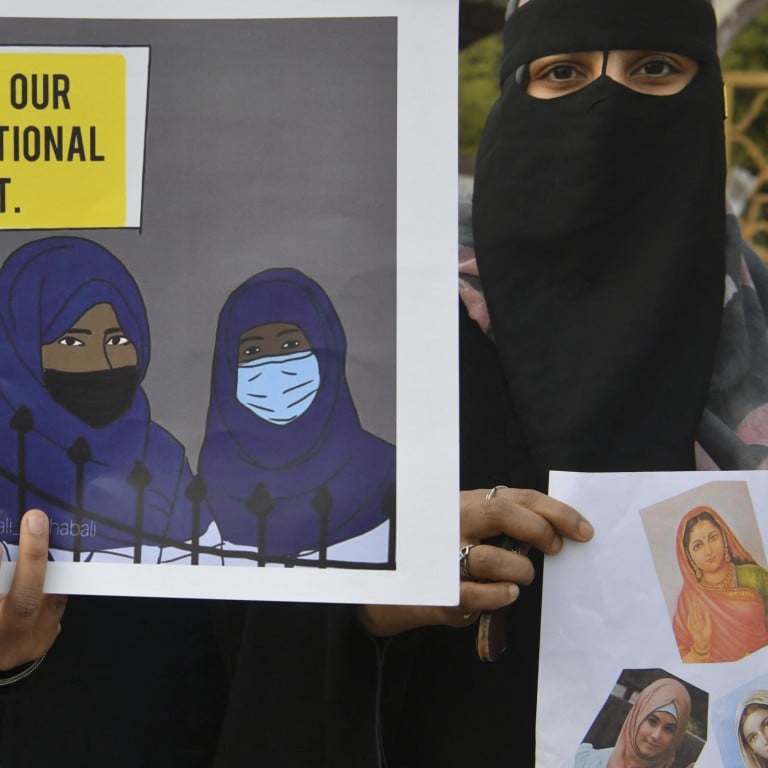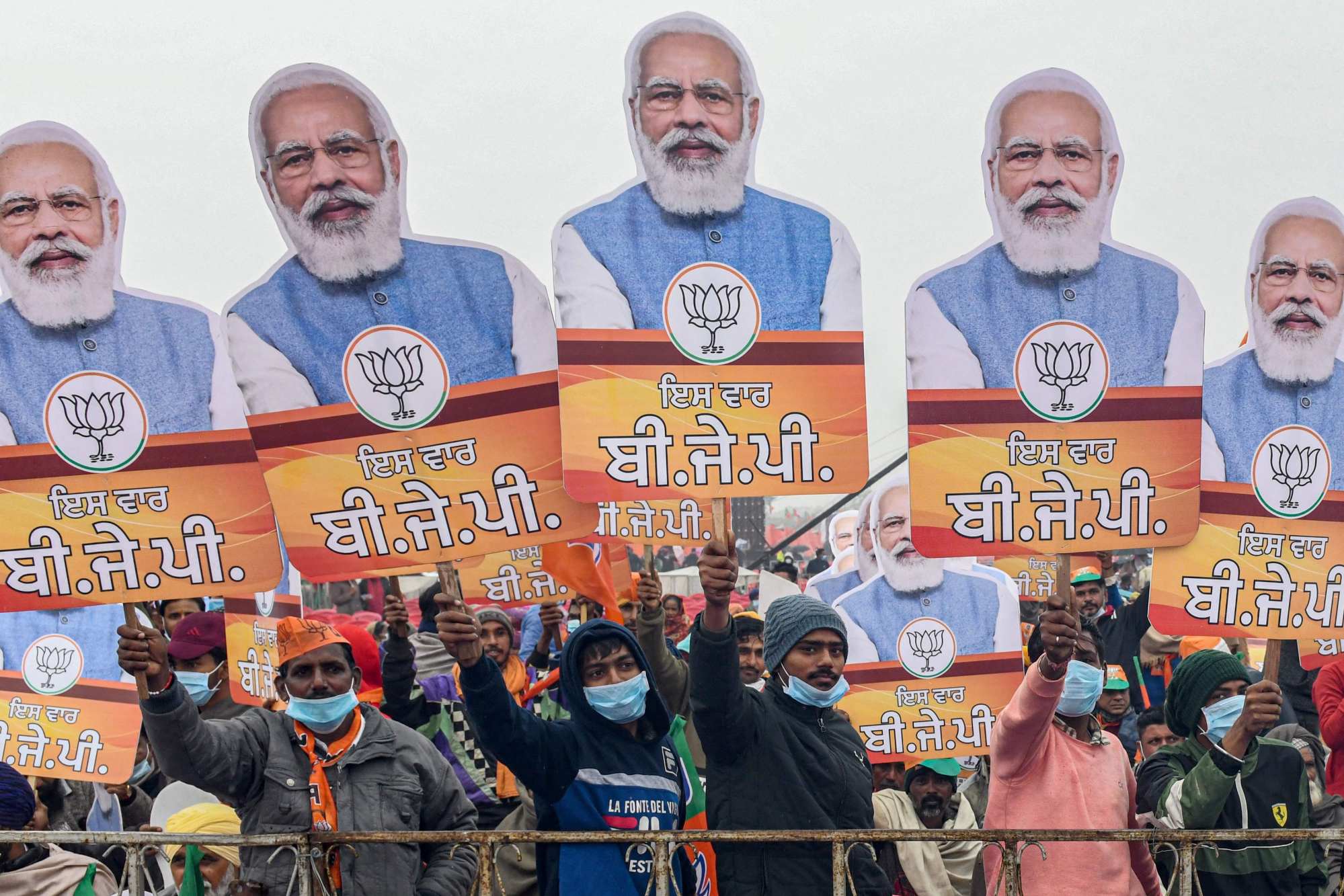
Violent clashes over students’ hijab ban lift the veil on fault lines in Narendra Modi’s India
- All schools and colleges in southern state of Karnataka have been closed after clashes between Hindu youths in saffron scarves and Muslims girls in hijabs
- Controversy lays bare growing divides in the multi-faith, multi-ethnic land and highlights concerns over the Hindu-nationalist BJP government’s agenda
All schools and colleges in the state have been closed until Friday after clashes broke out between Hindu youths wearing saffron scarves and Muslim girls in hijabs and their supporters.
Since last month, female students at half a dozen pre-university colleges in Karnataka have been prevented by the college authorities from entering the classroom on account of their hijab. The dispute first broke out at a college in Udupi and later spread to colleges in other districts.
The girls have stood outside college gates to protest against the ban, saying they are being denied their rights to education and to practise their religion – both of which are enshrined in the constitution.
The college principals have insisted that the uniform dress code for all students must be followed and the hijab is not a part of it. The state government has backed their stand.

A sign of polarised times
This week has seen the controversy reach a higher pitch, both in terms of the rhetoric on all sides and the fact that the Muslim girls filed a petition in the Karnataka High Court demanding the right to attend classes in a hijab.
Politically, the sides are forming along familiar lines. Opposition parties and liberals accuse the state government of “dirty politics” and of targeting Muslims yet again.
As it is, Muslim men can be dragged to jail on suspicion of seducing Hindu women to convert them to Islam; Muslim butchers and meat traders have lost their livelihood owing to the BJP’s cow protection policies; vigilantes attack Muslims for transporting cows, considered holy by some Hindus; and in December Hindu priests called for the “ethnic cleansing” of Muslims.
Uproar in India at Hindu teen’s death amid ‘forced Christian conversion’
In the hijab row too, the BJP has used bellicose language. The Karnataka BJP president Nalin Kumar Kateel denounced the demand to wear the hijab as the “Talibanisation” of educational institutions.
Since Muslims are such a beleaguered minority, even feminists who might once have denounced the hijab as a repressive patriarchal symbol feel uncomfortable doing so.
“You feel that if Muslim women want to assert their identity in this way because they have been marginalised by the BJP’s majoritarian agenda, it’s sort of understandable even though as a feminist I don’t approve of the hijab,” said Leena Patil, a Hindu university student in Mysore, in south Karnataka.
Others feel that it is wrong to automatically assume that the girls have been forced to wear the hijab. “In this case the students have made their preference very clear. So why the presumption of coercion?” asked Mihira Sood, visiting professor at the National Law University in Delhi in a column for the Times of India.

Hard to fathom
The BJP’s stand over the hijab is difficult to fathom given that Indians in this massively diverse, heterogeneous, multi-faith and multi-ethnic land have generally dressed however they wish.
Sikhs wear turbans to colleges and offices. Jains often wear masks covering their faces. Married Hindu women wear a particular necklace indicating their married status. Some Christians wear the crucifix. All manner of external religious symbols are on display.
Indeed, traditionally the Indian model has been the antithesis of the French tradition of laicite in which no religious symbols are permitted in public places.
For its part the BJP says it has never argued that Muslim women cannot wear a hijab or a burqa – only that religious outfits are inappropriate in educational institutions.
But for the BJP’s opponents, this stand is hypocritical. The party appointed a Hindu monk, Yogi Adityanath, as chief minister of Uttar Pradesh state yet the hijab is decried as a religious emblem that cannot be allowed in a college.
A Hindu attacks Sikhs in Australia, gets hero’s welcome in India
Even more ironically, some of the college principals have invoked “secularism” as the reason why the hijab will not be allowed. They said student clothes inside a classroom should not carry any religious affiliation.
“Since 2014, the BJP has been trampling on India’s secular ethos by making it a more overtly Hindu nation. Now they have suddenly discovered secularism when it comes to the hijab,” said a Muslim cleric in Delhi.
Mirroring the way Hindu vigilantes have gone after Muslims in the north if the latter assert their rights, in Karnataka too, male Hindu students turned up at outside the colleges. Wearing saffron scarves (saffron is the colour of Hinduism), they shouted: “If the hijab is allowed, then we will wear Hindu symbols.”
By and large, south India has not witnessed the same ancient Hindu-Muslim animosities as the north, at least not in its politics. The southern states are ruled mainly by regional parties which tend to promote their own cultures and languages as distinct from the Hindu revanchism that has taken hold in parts of north India.
But the BJP is eager to spread in the south and in 2019, it came to power in Karnataka. Some political analysts say it is exploiting the hijab issue to further its anti-Muslim agenda.

Political analyst Parsa Venkateshwar Rao suggested that, irrespective of the rights and wrongs of the case, the issue might be murkier than it seems. He said it was not a case of just one or two individual students wishing to wear the hijab.
“It has been a concerted and organised campaign which makes me think that a group is behind it, a group whose motivation isn’t clear but which is using the girls. They were not wearing the hijab before but now simultaneously many of them are demanding it,” Rao said.
The final verdict will come from the Karnataka High Court. On Tuesday, the judge hearing the petitions from Muslim girls said: ‘We will go by reason, by law, not by passion or emotions. We will go by what the constitution says.”

